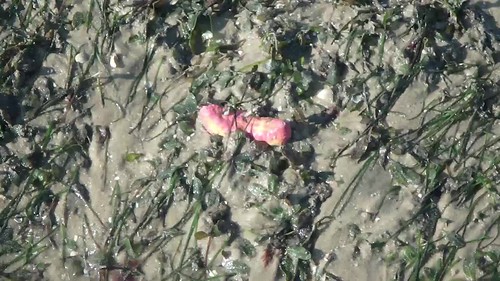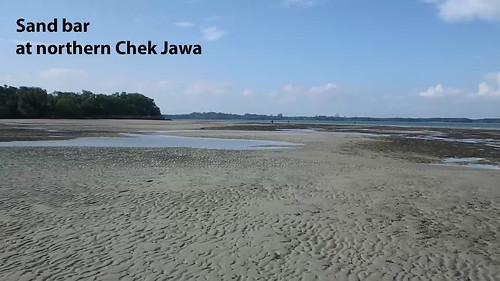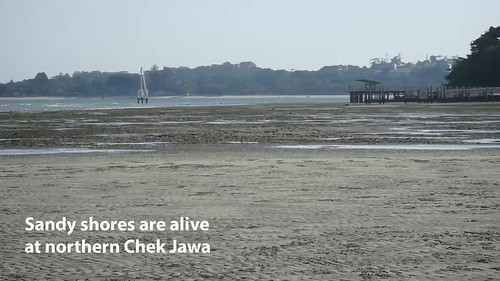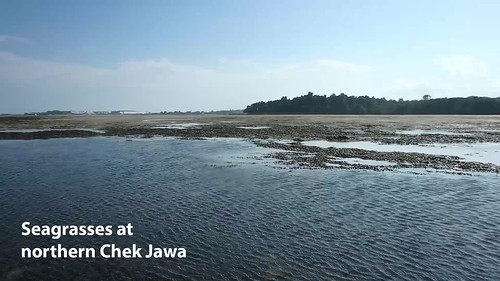The northern sand bar seems to be moving southwards and lush seagrasses forming on its northern edge.
My last trip here was with TeamSeagrass in Jan 2013. I was surprised to see broad seagrass meadows on the northern edge of the sand bar facing Johor! The sand bar appears to have moved southwards. Here's a video of the view.
The sand bar itself is still there but now ringed with seagrass meadows at mid tide, except at its eastern tip. Here's a video of the view.
The sandy shores are still very much alive! There were lots of signs of Sand bubbler crabs, Soldier crabs, Acorn worms, Straw tubeworms. And many prints of shore birds. Hermit crabs of all kinds were also common. Although we failed to find any living Button snails here.
I only saw one Plain sand star with broken arms, but plenty of Cake sand dollars. Kok Sheng found two and Chay Hoon saw one Common sand star which are no longer common on Chek Jawa since the mass deaths of 2007. The team also saw some Biscuit sea stars and a Painted sand star.
It's good to see common animals on Chek Jawa, such as the Gong gong snail, Ball moon snail, Weasel olive snail. There were also many Noble volutes, some laying eggs, and a Tiger moon snail. A special mollusc found by Kok Sheng is the Watering pot shell. Also an uprooted Spiky sea fan. And Jonathan and Sankar found a bunch of cephalopod eggs! These are black when the eggs are still developing and turn transparent just before the babies hatch. Kok Sheng saw a Pygmy squid. There were many moults of small Flower crabs. The team also saw Stone crabs and snapping shrimps.
In 2007, there was mass deaths of Haddon's carpet anemones and other animals at Chek Jawa. This is believed to be due to heavy rainfall as marine life can't cope well with too much freshwater. There are now plenty of Haddon's carpet anemones of all colours and sizes on the seagrass meadows. None of them were bleaching although some were pale. These animals eat all kinds of other animals. I saw one with a crab in its mouth, and another with several sand dollar skeletons nearby. There were also many Common cerianthids.
There were also many Garlic bread sea cucumbers, some of them nestled under the carpet anemones. Other animals found near the anemones include Ball sea cucumbers and Solitary tubeworms. The other anemone commonly seen were Big hermit-hitching anemones.
There were many small Warty pink sea cucumbers, and some small Thorny sea cucumbers. Also one Beige sea cucumber. Sankar saw an Orange sea cucumber.
The rest of the team spotted fishes such as the Slender sea moth, Kite butterflyfish and Shadow goby. They also saw a Mangrove horseshoe crab.
The seagrasses are growing lush at the northern edge as well as in the middle of the Chek Jawa lagoon. Spoon seagrass covered large areas, as well as Needle seagrass. I also saw some Fern seagrass. The sand bar near the pontoon has moved westward towards the boardwalk and is surrounded by lush seagrass meadows including lots of Smooth ribbon seagrasses. But I couldn't find any Beccari's seagrass in the north or in the middle near the boardwalk pontoon.
Much of the seagrasses in both the northern edge and middle of the lagoon were covered with black scummy growths. Cyanobacteria?
A closer look at the black scummy growths. Kok Sheng saw what seems like dugong feeding trails.
Mangroves fringe the route to the northern shoreline of Chek Jawa. The trees were doing well, although some were being buried in sand.
At the same time, there is a great deal of erosion on other parts of the shore with trees falling over both towards the sea and towards the land. Under this tree, at the red arrow is what looks like a tiny shrub of the very rare Critically Endangered Mentigi (Pemphis acidula).
Here's the bush under the fallen tree.
A closer look at the bush. It wasn't flowering or fruiting. The last time we saw a Mentigi bush here was in Jan 2011. It was a much bigger bush and might be a different one from this.
On the rocky shore near the boardwalk, the Critically Endangered Delek air (Memecylon edule) is fruiting.
I had a closer look at the area where the Security Barrier aka fence around the northern shore of Pulau Ubin starts.
Right at the fence, there was a big pile of trash that looks like they were dumped there. Because I know barbed wire doesn't float.
There is also a lot of other trash on the high shore that looks like they might have floated over.
On the tip of the northern sand bar facing the Johor River, there was hardly any trash washing up. Only natural flotsam of mangrove leaves, fruits and flowers.
The water in the Johor Strait looked alright. Usually, if the churn looks like teh-o then there is probably a plankton bloom going on.
We were treated to a beautiful sunset as we headed home.
Thanks to NParks for permission to survey this shore and keep tabs on how it is doing.
Photos by others on this survey
- Loh Kok Sheng on facebook and his blog.
- Jianlin Liu on facebook.
- Marcus Ng on facebook.
- Toh Chay Hoon on facebook.
- Sankar on facebook.
- Jonathan Tan on facebook.
- Rebecca Loh on facebook.
- Dayna on facebook.
- Juria Toramae on facebook.
- Lisa Lim on facebook.























